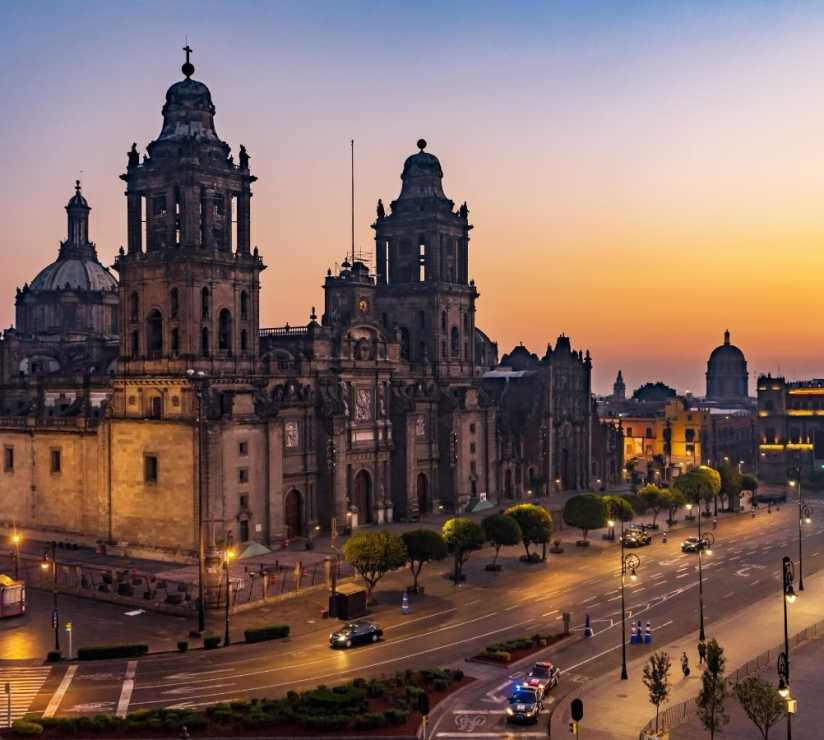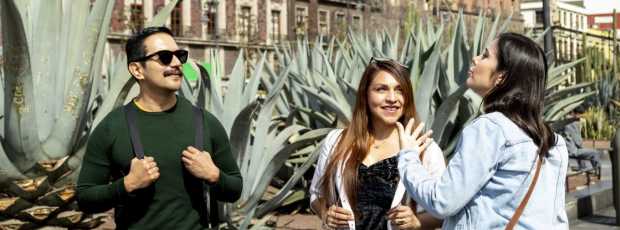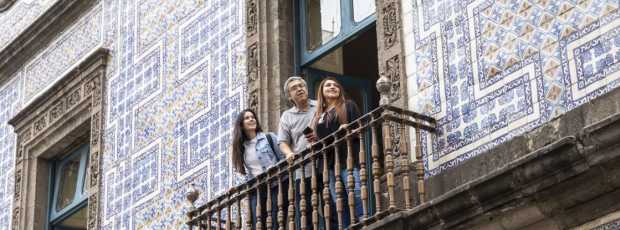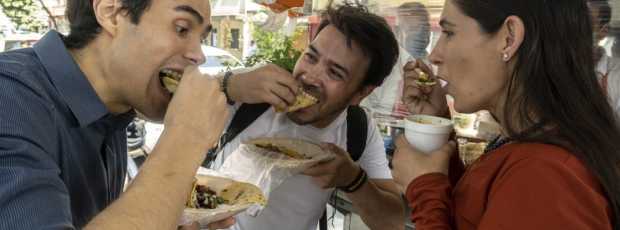Table Of Contents
- Friday Evening: Roma Norte's Golden Hour
- Saturday Morning: Chapultepec Park's Family Rhythm
- Saturday Afternoon: Diego Rivera and the Centro Histórico
- Saturday Evening: Street Food and Market Culture
- Sunday Morning: Art and Neighborhoods
- Sunday Afternoon: Palacio de Bellas Artes and Modern Mexico
- Sunday Evening: Churros and Reflection
- Planning Your Mexico City Weekend
Every time a friend asks me about planning a weekend in Mexico City, I tell them the same thing: forget the guidebooks for a moment. Let me share what three days in my city actually feel like when you move through it like family, not a tourist.
I've lived in Mexico City my entire life, and after hosting countless visitors over the years, I've learned that the best weekend in Mexico City isn't about checking boxes. It's about understanding rhythms, the way Friday evening settles into Roma Norte's tree-lined streets, how Saturday mornings belong to families in Chapultepec Park, and why Sunday afternoons were made for lingering over coffee in Coyoacán.
This is the Mexico City weekend itinerary I always recommend, tested through years of showing friends and family how to fall in love with my city in just a few days in Mexico City. It's rooted in neighborhoods where locals actually spend their time, centered around incredible food that tells our stories, and paced like we actually live here, with plenty of time for those sacred Mexican moments of sobremesa.
Friday Evening: Roma Norte's Golden Hour
When I plan a long weekend in Mexico City, I always tell visitors to arrive on Friday if possible. There's something magical about beginning your Mexico City weekend as the city shifts from work mode to weekend energy, and nowhere captures this transition better than Roma Norte.
Start your evening with coffee at one of Roma Norte's legendary cafés. I'm partial to Café Negro, where the afternoon light filters through large windows and the baristas know their beans like poets know their verses. This isn't just any coffee shop, it's where Mexico City's creative community has gathered for decades, and you'll understand why within minutes of settling into one of their worn leather chairs.
Walk through Roma Norte's residential streets as the golden hour begins. The art deco dwellings here tell the story of Mexico City's early 20th-century boom, when this neighborhood was home to the city's growing middle class. Today, these same buildings house artists, writers, and young professionals who've given Roma Norte its distinctive creative energy.
The beauty of Roma Norte is how it balances historic architecture with contemporary Mexican culture. You'll pass boutiques selling handmade goods next to century-old buildings, street art that speaks to current social movements alongside carefully preserved facades that Diego Rivera called home during his early career.
As darkness falls, it's time for dinner, and in Mexico City, that means tacos al pastor. Head to Tizoncito, where they've been perfecting al pastor since the 1960s. The vertical spit, the precise carving technique, the perfect balance of pineapple and meat. This is where tacos al pastor became the Mexico City institution we know today.
Watching the taquero carve al pastor is part of the experience. The rhythmic slicing, the quick flip of tortillas on the plancha, the careful assembly of each taco with just the right amount of salsa verde. It's street food elevated to art form. Order yours with extra piña and don't skip the grilled onions.
End your Friday evening with a walk through Roma Norte's nighttime streets. The neighborhood transforms after dark, with intimate restaurants spilling light onto sidewalks and locals gathering in small grupos outside their favorite bars. This is when you'll understand why Roma Norte has become the heart of Mexico City's cultural renaissance.
This evening routine perfectly captures what makes a weekend in Mexico City special. The seamless blend of culture, food, and neighborhood life that defines authentic Mexican urban living.
Saturday Morning: Chapultepec Park's Family Rhythm
Saturday mornings in Mexico City belong to families, and the epicenter of weekend family life is Chapultepec Park. Bosque de Chapultepec is often compared to New York's Central Park, but that comparison misses the point entirely. This isn't just green space in an urban environment, it's where generations of chilangos have created weekend traditions that define what it means to live in Mexico City.
Arrive early, around 9 AM, when the morning light is still soft and the park is filling with families setting up for their Saturday rituals. You'll see grandparents laying out blankets for picnics, children racing toward playgrounds, and teenagers gathering around the lake with guitars and conversation.
The anthropology museum sits like a modernist temple within Chapultepec, and it deserves your full attention. This isn't just one of Mexico City's must-see attractions, it's where Mexico's relationship with its indigenous past comes into focus. The building itself, designed by Pedro Ramírez Vázquez, represents the architectural ambitions of 1960s Mexico, but the collections inside tell stories that stretch back millennia.
Don't try to see everything in the anthropology museum. Instead, focus on the Mexica (Aztec) hall, where the famous Stone of the Sun anchors displays that help you understand the sophisticated urban civilization that existed here long before Spanish colonization. The museum's famous umbrella-shaped fountain in the central courtyard provides the perfect spot for reflection between galleries.
After the museum, walk through bosque de Chapultepec itself. The park's trails wind past vendors selling esquites and paletas, families gathered around portable speakers playing everything from rancheras to contemporary pop, and couples finding quiet corners for conversation under ancient ahuehuete trees.
If you have energy remaining, climb up to Castillo de Chapultepec. The castle offers panoramic views over Mexico City, but more importantly, it houses museums that help you understand how this city grew from Tenochtitlan to the sprawling metropolis of today. The castle's European-style architecture tells the story of Mexico's 19th-century relationship with European culture, while the views from its terraces remind you that you're standing on land that has been sacred to different civilizations for over 700 years.
A Saturday morning in Chapultepec Park reveals why locals consider these green spaces essential to Mexico City life. They're where families maintain connections across generations and where the city's cultural identity renews itself every weekend.
Looking for a private city experience in Mexico City?
Explore the city with a local who plans a private day just for you; no groups, no scripts.
Saturday Afternoon: Diego Rivera and the Centro Histórico
The afternoon heat in Mexico City calls for the shaded corridors and cool stone of the Centro Histórico, and this is when you'll encounter Diego Rivera's most powerful work in its original context. The Centro Histórico isn't just Mexico City's historic district, it's where the layers of Mexican history press up against each other in ways that make the past feel immediate and urgent.
Start at the National Palace, where Diego Rivera murals cover the main staircase and upper corridors with scenes that trace Mexican history from pre-Columbian civilizations through the Mexican Revolution. These aren't just famous Mexican artists' decorations, they're Rivera's visual argument for how Mexico's indigenous past connects to its revolutionary future.
The murals demand slow viewing. Rivera painted these walls during the 1930s and 1940s, when debates about Mexican identity were reshaping the country's cultural and political landscape. His depictions of Tenochtitlan's markets, Spanish colonization's violence, and revolutionary heroes like Zapata and Villa create a narrative that positions indigenous Mexico as the source of the country's authentic identity.
Step outside the National Palace onto Mexico City's main square, the Zócalo, and you'll stand in what has been the center of power in this valley for over 600 years. The Metropolitan Cathedral dominates the square's north side, its baroque towers rising from the same spot where Tenochtitlan's Templo Mayor once anchored the Aztec capital.
The Metropolitan Cathedral tells its own complex story. Built over nearly 250 years using stones from destroyed Aztec temples, it represents both Spanish colonial power and the indigenous labor that made that power possible. Inside, the cathedral's gold-leafed altars and European artistic traditions create spaces of profound beauty, but they also remind you that this beauty emerged from cultural conquest.
Walk through Mexico City's Centro Histórico streets surrounding the Zócalo. Every block reveals architectural layers. Art Deco facades from the 1930s built into colonial courtyards, contemporary shops occupying spaces that have housed commerce for centuries, street food vendors setting up where indigenous markets operated long before Spanish colonization.
The Centro Histórico can feel overwhelming, but focus on how different historical periods coexist rather than trying to see everything. This is where you'll understand that Mexico City isn't just built on top of Tenochtitlan. It's built from Tenochtitlan, incorporating indigenous urban planning, architectural techniques, and cultural practices into what became one of the world's great colonial cities.
The Centro Histórico and its Diego Rivera murals provide essential context for understanding Mexico City. They show how the city's contemporary culture grows from complex relationships between indigenous heritage, colonial history, and modern Mexican identity.
Saturday Evening: Street Food and Market Culture
As Saturday evening approaches, it's time to dive deeper into Mexico City's street food culture. Not as a tourist experience, but as a window into how food creates community in urban Mexico. The best way to visit Mexico City is to understand that our street food isn't just convenient or cheap, it's where culinary traditions adapt to city life while maintaining connections to regional Mexican cooking.
Consider joining a street food tour, but choose one led by locals who can explain the cultural context behind what you're eating. The best guides will take you to stands where they actually eat, introduce you to vendors they've known for years, and help you understand how different regional Mexican cuisines converge in Mexico City's street food scene.
Al pastor represents this convergence perfectly. The technique came from Lebanese immigrants in the early 20th century, but Mexican cooks adapted it using local chiles, indigenous cooking methods, and flavor combinations that reflect Mexico City's role as a meeting point for the country's diverse culinary traditions. When you eat al pastor in Mexico City, you're tasting how immigration, adaptation, and creativity produce new traditions.
Explore one of Mexico City's local markets for a different perspective on the city's food culture. Mercado San Juan, near the city center, offers everything from exotic meats to artisanal cheeses, but what makes it special is how it serves both restaurant chefs seeking unusual ingredients and neighborhood families doing their weekly shopping.
In the market, you'll see how Mexico City's incredible food scene emerges from the availability of ingredients from across Mexico and around the world. Vendors selling Oaxacan chiles work next to those offering Japanese vegetables, while traditional Mexican cooking techniques adapt to incorporate global ingredients.
Street food in Mexico City also means understanding the social rituals around eating. Notice how people gather around popular stands, how conversations develop between strangers waiting for their orders, and how eating becomes an opportunity for community building. The best street food stands become neighborhood gathering places where regulars catch up on local news and visitors get integrated into local social networks.
Try esquites from a street vendor, corn kernels served in cups with mayo, cheese, chile, and lime. This isn't just a snack; it's a perfect example of how indigenous Mexican ingredients (corn, chile) combine with European additions (cheese, mayo) to create something distinctly Mexican and distinctly urban.
Mexico City's street food culture reveals how the city maintains connections to regional Mexican traditions while constantly creating new culinary possibilities, it's where tradition and innovation meet on every street corner.
Sunday Morning: Art and Neighborhoods
Sunday mornings in Mexico City call for a slower pace, and there's no better place to experience this rhythm than Coyoacán, where cobblestone streets and colonial architecture create spaces perfect for wandering and reflection. Coyoacán feels like a small town within Mexico City, but it's also where some of Mexico's most important modern art and cultural movements took root.
Start with the Frida Kahlo Museum, Casa Azul, but understand that you're not just visiting a famous Mexican artist's home. You're entering the space where Kahlo developed her artistic vision while navigating the tensions between Mexican nationalism, international modern art movements, and personal expression that defined Mexican culture in the mid-20th century.
The blue walls of Casa Azul contain Kahlo's personal belongings, unfinished paintings, and the garden where she spent her final years. But the museum also preserves the domestic spaces where Kahlo and Diego Rivera entertained international visitors, debated Mexican politics, and created art that helped define how Mexico would present itself to the world.
Reserve your Frida Kahlo Museum tickets in advance, it's one of Mexico City's most popular attractions, and weekend crowds can be overwhelming. But don't let the crowds distract you from the intimacy of the space. Kahlo's art emerged from her personal experience of pain, disability, and creative ambition, but it also reflected broader questions about what it meant to be Mexican in an increasingly globalized world.
After Casa Azul, walk through Coyoacán's market and surrounding streets. The weekend market offers everything from handmade crafts to regional Mexican foods, but it also provides insight into how traditional Mexican market culture adapts to serve both locals and visitors without losing its authentic character.
Coyoacán's art galleries showcase contemporary Mexican art that builds on traditions established by Rivera, Kahlo, and their contemporaries. These aren't just commercial galleries. They're spaces where emerging Mexican artists explore how contemporary Mexican culture relates to its complex history while engaging with global contemporary art movements.
The neighborhood's cafés and restaurants offer perfect spots for extended sobremesa. Those leisurely post-meal conversations that are essential to Mexican social culture. Find a table in Coyoacán's main plaza, order coffee and pastries, and watch how locals use Sunday mornings for family time, romantic conversations, and quiet personal reflection.
Coyoacán combines artistic heritage with contemporary Mexican culture in ways that show how Mexico City maintains connections to its cultural traditions while constantly evolving. It's where the past informs the present without constraining it.
What if your day in Mexico City was planned by someone who knows it — and you?
City Unscripted matches you with a local host who creates a private experience based on your interests, not a set route.
Sunday Afternoon: Palacio de Bellas Artes and Modern Mexico
No weekend in Mexico City feels complete without experiencing Palacio de Bellas Artes, which represents Mexico's cultural ambitions in their most concentrated form. This isn't just an opera house or art museum, it's where Mexico displays its relationship to both European high culture and indigenous Mexican artistic traditions.
The building itself tells the story of early 20th-century Mexico's cultural aspirations. Construction began under Porfirio Díaz's government, which sought to present Mexico as a modern, European-style nation, but the building was completed after the Mexican Revolution, reflecting the new government's emphasis on Mexican cultural nationalism.
Inside Palacio de Bellas Artes, Diego Rivera murals share wall space with work by other famous Mexican artists like José Clemente Orozco and David Alfaro Siqueiros. These murals represent the Mexican muralism movement's attempt to create public art that would educate Mexican citizens about their history while promoting social justice and national unity.
The palace's modern art exhibitions showcase how contemporary Mexican artists engage with global art movements while maintaining distinctly Mexican perspectives. These exhibitions change regularly, but they consistently explore themes that connect Mexico City's contemporary culture to its complex historical legacy.
If you're lucky enough to visit Mexico City during opera or ballet season, attending a performance at Palacio de Bellas Artes provides insight into how Mexico City's cultural elite has historically understood their city's place in global cultural hierarchies. The venue attracts world-class international performers, but it also showcases Mexican artists working in classical European traditions.
The palace's famous Tiffany glass curtain, depicting Mexico's landscape in Art Nouveau style, represents the complex relationship between Mexican identity and international artistic movements that has shaped Mexico City's cultural development throughout the 20th century.
Palacio de Bellas Artes demonstrates how Mexico City has consistently positioned itself as a center for both Mexican cultural nationalism and international artistic exchange — it's where local identity meets global ambition.
Sunday Evening: Churros and Reflection
As your weekend in Mexico City winds down, there's no better way to end than with churros con chocolate. Preferably from a street vendor who's been perfecting the recipe for decades. This isn't just dessert; it's participation in a tradition that stretches back to colonial Mexico while remaining essentially contemporary and urban.
Find a quiet spot in Roma Norte or Coyoacán for your final Mexico City meal. The best churros vendors operate small stands where you can watch the dough being extruded, fried to golden perfection, and dusted with sugar that dissolves slightly from the heat. The chocolate should be thick enough to coat a spoon, flavored with cinnamon and vanilla, and served hot enough that it stays warm throughout your leisurely consumption.
This is the perfect moment for reflection on what you've experienced during your days in Mexico City. The city reveals itself through layers; architectural, cultural, culinary, that don't always align neatly but create rich complexity. Your weekend has taken you from contemporary Roma Norte through pre-Columbian and colonial Centro Histórico to artistic Coyoacán, showing how different historical periods and cultural influences coexist in contemporary Mexico City.
What makes a weekend in Mexico City special isn't just the famous attractions, though the Diego Rivera murals, Frida Kahlo Museum, and anthropology museum provide essential context for understanding Mexican culture. It's how the city maintains traditions, from Sunday family gatherings in Chapultepec Park to elaborate street food preparation techniques, while constantly evolving.
Mexico City's neighborhoods each offer different perspectives on what it means to live in one of the world's great megacities while maintaining connections to regional Mexican culture, indigenous heritage, and family traditions that span generations. Your weekend has shown you how locals navigate these different cultural layers while creating contemporary Mexican urban culture.
The incredible food you've experienced; from sophisticated al pastor techniques to simple esquites preparation, demonstrates how Mexico City serves as a laboratory for Mexican cuisine, where traditional recipes adapt to urban life while incorporating influences from the city's diverse population.
As you finish your churros and prepare to leave Mexico City, you'll understand why locals are so passionate about their city despite its obvious challenges. This is a place where culture feels alive and constantly evolving, where traditions adapt rather than simply survive, and where every neighborhood offers different perspectives on what it means to be Mexican in the 21st century.
Your weekend in Mexico City has shown you a city that honors its complex past while creating its future, a place where every meal, every street corner, and every conversation contributes to an ongoing cultural conversation that spans centuries while remaining utterly contemporary.
Planning Your Mexico City Weekend
When you plan your own weekend in Mexico City, remember that this city rewards travelers who approach it with curiosity rather than just checking off attractions. The best Mexico City experiences emerge from understanding how locals actually live, eat, and spend their weekend time.
Book accommodations in Roma Norte or nearby Condesa for easy access to the neighborhood scenes that define contemporary Mexico City culture. Avoid staying in purely tourist areas that isolate you from local life. Part of what makes Mexico City special is how quickly you can feel like a temporary local rather than just a visitor.
Make restaurant reservations for Friday and Saturday evenings, but leave room for spontaneous street food discoveries. Mexico City's food scene combines world-class restaurants with incredible street food, and your weekend should include both.
Consider what not to do in Mexico City as carefully as what to include. Don't try to see everything, this city deserves deeper exploration of fewer areas rather than superficial coverage of many attractions. Don't stick only to tourist zones. The real Mexico City reveals itself in neighborhood markets, local cafés, and residential streets where people actually live.
Most importantly, build time into your Mexico City weekend for the kind of lingering conversations and extended meals that define Mexican social culture. The city's rhythm rewards patience and social connection over rushed sightseeing.
Your weekend in Mexico City will provide just enough time to understand why this city inspires such passionate devotion from locals and visitors alike. It's a place where every meal tells a story, every neighborhood reveals different aspects of Mexican culture, and every conversation offers insights into how one of the world's great cities maintains its identity while constantly evolving.
Come prepared to eat well, walk extensively, and engage with a urban culture that's simultaneously ancient and utterly contemporary. Your weekend in Mexico City will leave you planning your return before you've even left.
Tip
We match you with the right host, not just any guide.Want to experience the real Mexico City with someone who lives there?
A fully private experience, planned and led by a local host who tailors the day to you
Ready to plan your perfect day in Mexico City?
Start your experienceWhat if your day in Mexico City was planned by someone who knows it — and you?
City Unscripted matches you with a local host who creates a private experience based on your interests, not a set route.
Want to experience the real Mexico City with someone who lives there?
A fully private experience, planned and led by a local host who tailors the day to you











